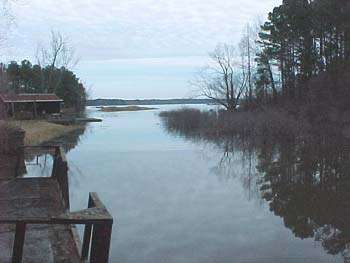Sam Rayburn Wildlife Viewing
category : Wildlife Viewing
 MAMMALS
MAMMALSAt Rayburn, like most areas, few mammals are observed during the day. The best times to see such animals as deer, fox, bobcat, furbearers, and bats is at dawn or at dusk. About the only mammals you will see exclusively during the day, and a lot of them, are tree squirrels. A trip through any of the parks at Rayburn will likely turn up a few squirrels. Of particular interest are the melanistic fox squirrels in Twin Dikes Park. Just beware when having a picnic lunch - you may observe more squirrels than you care to!
Deer are most often seen during the day at Jackson Hill, Powell, and Rayburn Parks. Raccoons and opossums seem to be more prevalent in Hanks Creek and Jackson Hill. Red fox have been observed regularly in Twin Dikes and Powell Parks. Nutria, otters, and mink can be found while driving across the many bridges that cross the lake, most notably the Ayish Bayou bridge on FM 83 and the Devil's Ford bridge on US 96 between Brookeland and Pineland.
HERPTILES AND INVERTEBRATES
And now for the good stuff - SNAKES AND BUGS! They may not be at the top of everyone's list of things to see , but Lake Sam Rayburn definitely has its share.
Being a body of water, Rayburn is home to a multitude of frogs and turtles. The frogs are most often heard and not seen. They usually sing you to sleep from spring through fall at any of the parks. Turtles are most often seen basking on logs in the lake or during the spring egg laying season, they may be noticed crossing sandy roads near the shoreline searching for a suitable nesting spot. Snakes may be found anywhere around the lake from early spring to late fall. The four poisonous snakes of North America. Are all represented at the lake, along with most of the non-poisonous species native to the eastern half of the country. The two species of most concern are the water moccasin (cottonmouth) and the copperhead. The water moccasin may be encountered anywhere there is water, so be alert; they are known to fearlessly stand their ground. The copperhead is the poisonous snake most found in the park areas due to the wooded nature of the parks and the leaf litter left on the ground. They tend to hide in leaf piles and brushy areas. Copperheads are found to usually be rather docile unless provoked. While it may not be desirable to have a snake near your campsite, just remember that if you don't bother them, they usually won't bother you. One species of reptile that doesn't often come to mind when you think of Sam Rayburn is the American Alligator, but they are more than a few in the lake. They usually keep to themselves and move at night, but a few have been spotted at various locations around the reservoir.
Invertebrates, most notably insects, are found in abundance in East Texas. Ticks, spiders and scorpions also make themselves known to unsuspecting wanderers. The insects to be most concerned with are wasps, hornets, bees, fireants, and the two species of dangerous spiders in the are, the Black Widow and the Brown Recluse. Two categories of insects that folks actually go out of their way to find around here are the dragon and damsel flies, and butterflies. The dragon and damsel flies can be found anywhere near a surface of water and the butterflies are commonly found around roadside ditches in the spring and summer.
Address: From Jasper, 15 mi NW on TX 63, then E on TX 255
Phone: 409-384-5716
Our Email: CESWF-OD-SR@swf.usace.army.mil
Come visit us in , Texas